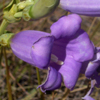SEARCH the
Gentian Research Network
and Rutgers University:
GENTIANS
Classification (newest)
List of genera
List by tribe
Gentian characteristics
Gentianales
RESEARCH
Research projects
People, addresses
Literature, publications
Links
Add info to
this site
TOPICS
Anatomy
Common names
Ecology - Natural history
GEOGRAPHY
Floras
Latin America
North America
TRIBES
Saccifolieae
_____________________
Information in other languages:
_____________________
This page
is maintained
by Dr.
Lena
Struwe
(e-mail),
and hosted by
Rutgers University, USA
updated: 01/19/11
| The convoluted history of Lisianthus, Lisianthius, and Lisyanthus | ||||||||
|
Three different gentian groups have been called Lisianthus:
1. The genus Lisianthius, which has it as its Latin genus name.
2. The genus Chelonanthus
and related genera, which previously belonged 3. The genus Eustoma, which is called lisianthus in English.
This is the story: Browne described the genus Lisianthius from the Caribbean, and Linnaeus soon changed the spelling to Lisianthus. Soon after, Aublet described a genus named Lisyanthus from French Guiana. This was either a new genus with a very similar name to an existing genus, or he changed the spelling for Lisianthius again. Scientists don't know what the intention was, but the species that belong to Aublet's group are not related to Browne's species, so they formed different groups. However, most botanists treated the whole group of species as Lisianthus for centuries, while adding more species. But according to naming rules (the Botanical Code), the spelling of the oldest name had to be followed, so today Lisianthius is the correct spelling.
In the meantime, the genera Irlbachia and Helia had been described from Brazil by Martius (1827). These two genera are related to the genera Calolisianthus, Macrocarpaea and Chelonanthus (which were formerly sections of Lisianthus/ Lisyanthus, and were excluded from it in the mid- to late 1800s). The Lisyanthus species of Aublet, were put into Chelonanthus. Several authors (for example Steyermark) did not accept the segregated genera and used the name Lisianthus for species from continental South America into the 1960s.
All Lisianthus species from South America (not Central American and Caribbean) were excluded from Lisianthius and put in Helia by Kuntze in late 1800s (including species now in Irlbachia, Macrocarpaea, Chelonanthus and Calolisianthus). Nobody really cared what Kuntze had done, however. Most people after that continued with the same segregate genera as earlier. In 1985, Maas and his collaborators combined Chelonanthus, Helia, and Calolisianthus with Irlbachia, creating a much larger Irlbachia - the only problem was that Helia should have been the name of this large genus, not Irlbachia, because of rules of priority (Kuntze had already decided that Helia had priority over Irlbachia).
And now today, with molecular data and phylogenetic methods, we know more about how species are related. The Caribbean and Central American Lisianthius species is a distinct genus in the tribe Potalieae, whereas the continental South American (and a few outliers) species should be put into the genera Chelonanthus, Calolisianthus, Helia, and Irlbachia, respectively, which are part of tribe Helieae. Nobody uses the spelling Lisianthus or Lisyanthus anymore, except as an English name for a non-related gentian (see below).
And then there is Eustoma - a Caribbean/ southern United States genus of 2-3 species that are commonly cultivated. The common name for one of the species is lisianthus, and as far as I know it has never had the Latin name Lisianthus (or any other spelling thereof). It is unknown how this English names was given to this plant because Eustoma is not very similar to either Lisianthius or the South American Chelonanthus-relatives, and belongs to a different tribe, the Chironieae. Another common name for Eustoma is prairie gentian.
Aublet, M. F. 1775. Histoire des plantes de la Guiane Françoise, vol. 1. P.-F. Didot, London & Paris. Browne, P. 1756. The civil and natural history of Jamaica in three parts, ed. 1. T. Osborne & J. Shipton, London. Kuntze, C. E. O. 1891. Revisio generum plantarum, vol. 2. Arthur Felix, Leipzig. Martius, C. F. P., von. 1826-27. Nova genera et species plantarum quas in itinere per Brasiliam, vol. 2. V. Wolf, München. IMAGES Maas, P. J. M. 1985. Nomenclatural notes on neotropical Lisyantheae (Gentianaceae). Proc. Kon. Ned. Akad. Wetensch., Ser. C, 88: 405-412. Struwe, L. & V. A. Albert. 1998. Lisianthius (Gentianaceae), its probable homonym Lisyanthus, and the priority of Helia over Irlbachia as its substitute. Harvard Pap. Bot. 3: 63-71. Struwe, L., J. W. Kadereit, J. Klackenberg, S. Nilsson, M. Thiv, K. B. von Hagen, & V. A. Albert. 2002. Systematics, character evolution, and biogeography of Gentianaceae, including a new tribal and subtribal classification. Pp. 21-309. In: L. Struwe & V. A. Albert (eds.), Gentianaceae: Systematics and Natural History, Cambridge University Press, Cambridge.
© Lena Struwe, 2007 |






